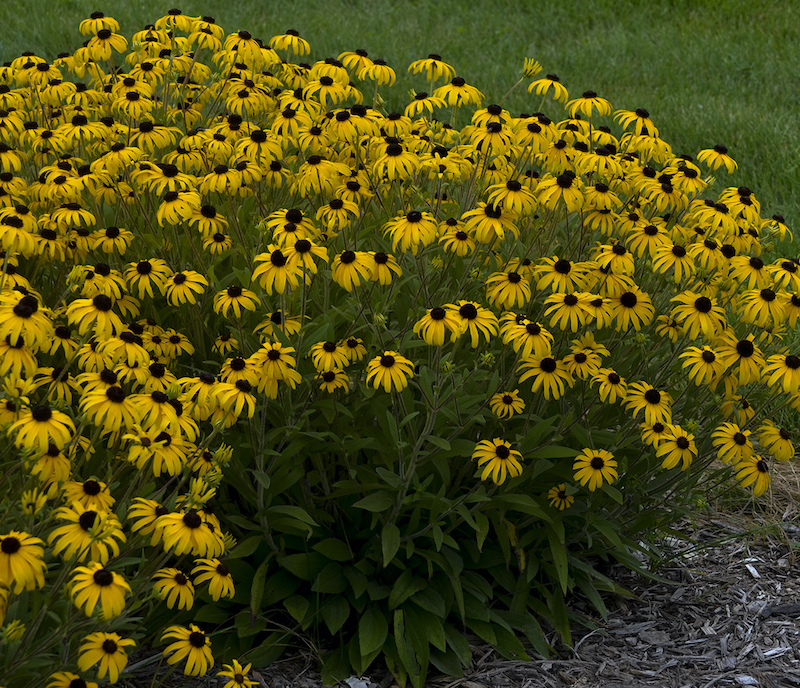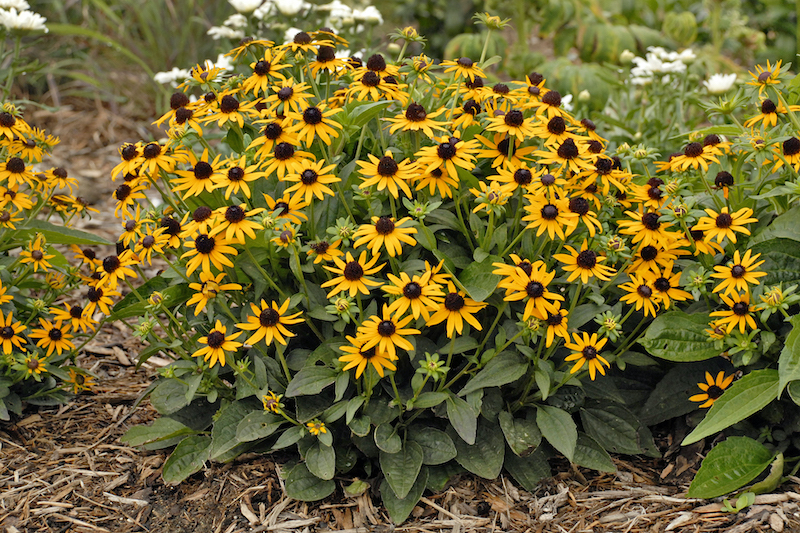Growing Black-Eyed Susan
Black-Eyed Susan is an herbaceous perennial that is part of the Rudbeckia genus of plants. There are over 40 varieties and cultivars of Rudbeckia, all of which have some sort of dark black, brown, or greenish eye at the center of their flower. Black-Eyed Susan will grow in areas that have poor soil and lots of sun. They also tend to set seeds easily and can self-sow and naturalize in open meadows or large garden areas. All Black-Eyed Susans are cold-hardy and survive the winter by dying back to the ground in fall and staying dormant until spring. The flowers are not only lovely in a vase, but are great attractors of insect pollinators, butterflies, and birds. Annual and perennial varieties of Black-Eyed Susan are planted and grown the same. The annual varieties can be allowed to self-seed each summer, providing new plants every spring.

There is a tropical vine that also has the name Black-Eyed Susan. Black-Eyed Susan vine is in the Acanthaceae family. Thunbergia alata is the genus and species name for this vining plant. In most growing zones of the United States, Black-Eyed Susan vine is grown as an annual and is only a true perennial in zones 10 and 11.

Planting Black-Eyed Susan
Plant Black-Eyed Susan in full sun in well-draining soil. All soil textures are acceptable. Heavy clay soil can be amended with compost to improve drainage. Place the plants at the same depth in the ground that they were growing in the pot. Planting Black-Eyed Susan too deep will keep it from blooming well and may rot the crown. Mulch around the base and root area of Black-Eyed Susan to improve the soil texture and moisture retention over time. Using organic compost will also supply the nutrients needed to support healthy growth for the whole season.
Watering Black-Eyed Susan
Black-Eyed Susan is very drought tolerant after it has established and matured. Consistent watering when the plant is young will help it produce a strong root system. Watering with soaker hoses and drip irrigation helps to direct water to the roots while keeping the leaves dry. MIldews and fungal diseases are common to Black-Eyed Susan and are easily transmitted by water on the foliage. The average amount of water required each week is between 1/2 -1 inch.
Fertilizing Black-Eyed Susan
Black-Eyed Susan does not need much supplemental fertilizing. An annual feeding with a slow-release granular fertilizer is enough to support healthy growth and blooming through the summer. A complete fertilizer will supply all three macronutrients, NPK, in different ratios. Look for a fertilizer that has slightly higher nitrogen (N) and phosphorous (P) content. Potted perennials should be fertilized more often through the summer. A diluted liquid feed should be applied once a month, ending in August so that the plants can prepare for dormancy.

Pruning Black-Eyed Susan
Black-Eyed Susans require two types of pruning each year. First, spent flower spikes should be deadheaded during the summer. This will help encourage continued blooming and color well into the fall. The second is removal of dead plant material in the fall or early spring, depending on your hardiness zone. The colder zones (3-6) will see Black-Eyed Susan die back to the ground after the first few frosts.
This is the time to cut the plant back to within 2 inches of the ground and apply a mulch for the winter. The warmer zones will be able to let the plant die back over the winter. New leaves may even emerge before winter and stay small until the spring. The last round of flower stems may also be left on the plant to form seed and feed the birds and other wildlife all winter.
Caring For Black-Eyed Susans in Pots
Black-Eyed Susan grows well in a container with ample drainage. The smaller varieties of Black-Eyed Susan make wonderful additions to containers with mixed seasonal plants. Common companions for Black-Eyed Susan are ornamental grasses, Thyme, Lavender, prostrate Rosemary and Coneflowers. Regular fertilizing during the summer months will be necessary to keep plants healthy and blooming. Diluted liquid fertilizers like fish emulsion or a seaweed blend should be applied once a month. All fertilizing will need to be finished by August so that this perennial can harden off and prepare for dormancy.
Winter Care for Black-Eyed Susan
The hardy nature of Black-Eyed Susan makes it a low-maintenance winter plant. The main consideration is drainage. Poor drainage during the winter is the downfall of most perennials and shrubs. Areas of the garden that seem well drained during the heat of the summer could become waterlogged during the winter months in areas with plentiful rain.
If Black-Eyed Susan is growing in the garden and seems to be too wet during the winter, it can be dug up and temporarily potted to spend the rest of the winter in a sheltered spot. Using mulches of finely shredded bark, leaves or compost will help to insulate the crowns from the cold. Any mulch placed over crowns for the winter must be removed in early spring to prevent rotting and improve air circulation.
Common Care Questions About Black-Eyed Susan
How Do You Save A Dying Black Susan?
Rejuvenation can be attempted by trimming off the top 1/4 to 1/3 of the plant, paying particular attention to the dead or dying foliage but leaving behind as much healthy, green foliage as you can so it can gather energy from the sun. Place mulch around, but not touching the plant to conserve moisture than water slowly and deeply once or twice weekly.
How Long Does It Take For A Black-Eyed Susan Vine To Bloom?
Black Eyed Susan generally reaches maturity in around 60 days and blooms from all summer long, June to September.
Why Are The Leaves On My Black-Eyed Susan Turning Black?
Leaf Spot is fairly common with Black Eyed Susans and more prevalent late in the summer, with hot and humid weather. Leaf Spot is fungal, usually Septoria or Cercospora. Fungicides can be helpful, with applications early and often, as long as the hot, humid weather prevails.
Will Black-Eyed Susans Grow In Shade?
While Black Eyed Susans can tolerate some shade, they may become leggy and sparse, as they grow towards and reach for more sunlight.
How Long Do Black-Eyed Susans Live?
Black Eyed Susans are usually grown as biennials, lasting only two years before seeding prolifically if allowed to do so, and then dying.
Are Black-Eyed Susan An Annual Or Perennial?
Neither, Black Eyed Susan is most often biennials!
Are Black-Eyed Susans Edible?
Black Eyed Susan is not poisonous, though it should not be ingested. For some people, it can cause allergic reactions or even asthma attacks.
Are Black-Eyed Susans Invasive?
Black Eyed Susan is a heavy self-seeder if allowed to be, but is not considered to be invasive.
Why Are Black-Eyed Susan Leaves Turning Yellow, Brown, and/or Black?
Two of the most common reasons for yellowing leaves on Black Eyed Susans are fungal infections of either powdery mildew or rust. Powdery mildew initially presents white and yellows over time. Rust will present with white, orange, and yellow spots both on the top side and the bottom of the leaves. Removal and disposal of infected foliage and increasing air circulation around the plants are recommended, as well as watering at the base of the plant and keeping leaves dry, rather than from above.
What Is The Growth Rate Of Black-Eyed Susans?
Black Eyed Susans are considered to be fast growers.
Are Black-Eyed Susans Drought Tolerant?
Black Eyed Susans are drought tolerant and easy to care for.
Have a question about Black-Eyed Susan? Fill out the form below and we will try and get back to your question as soon as possible. We may even feature your question in this article to help other gardeners!
This page contains affiliate links to products on Amazon. We may receive a commission for purchases made through these links.
 |
Author Robbin Small - Published 7-31-2022 |
